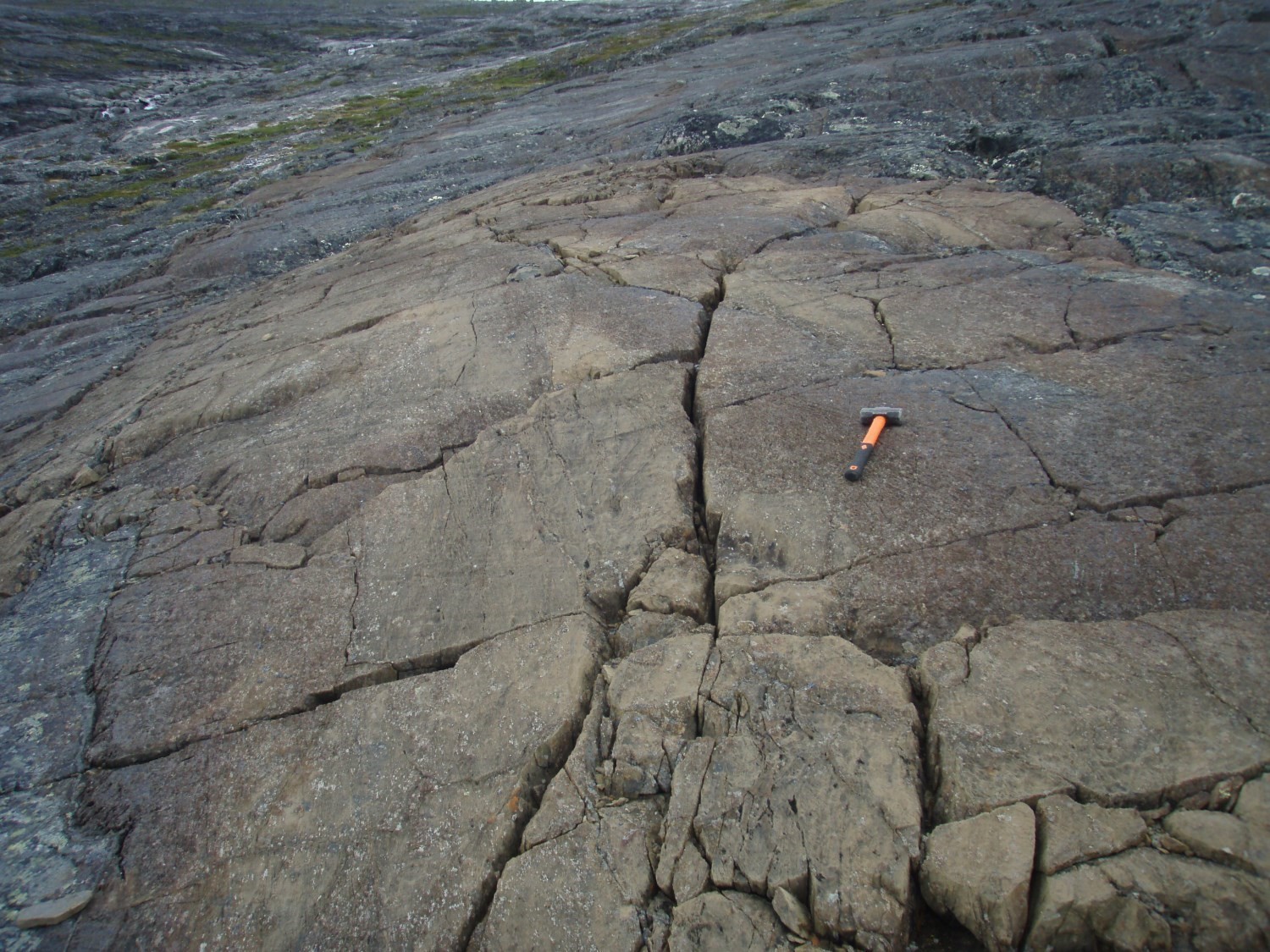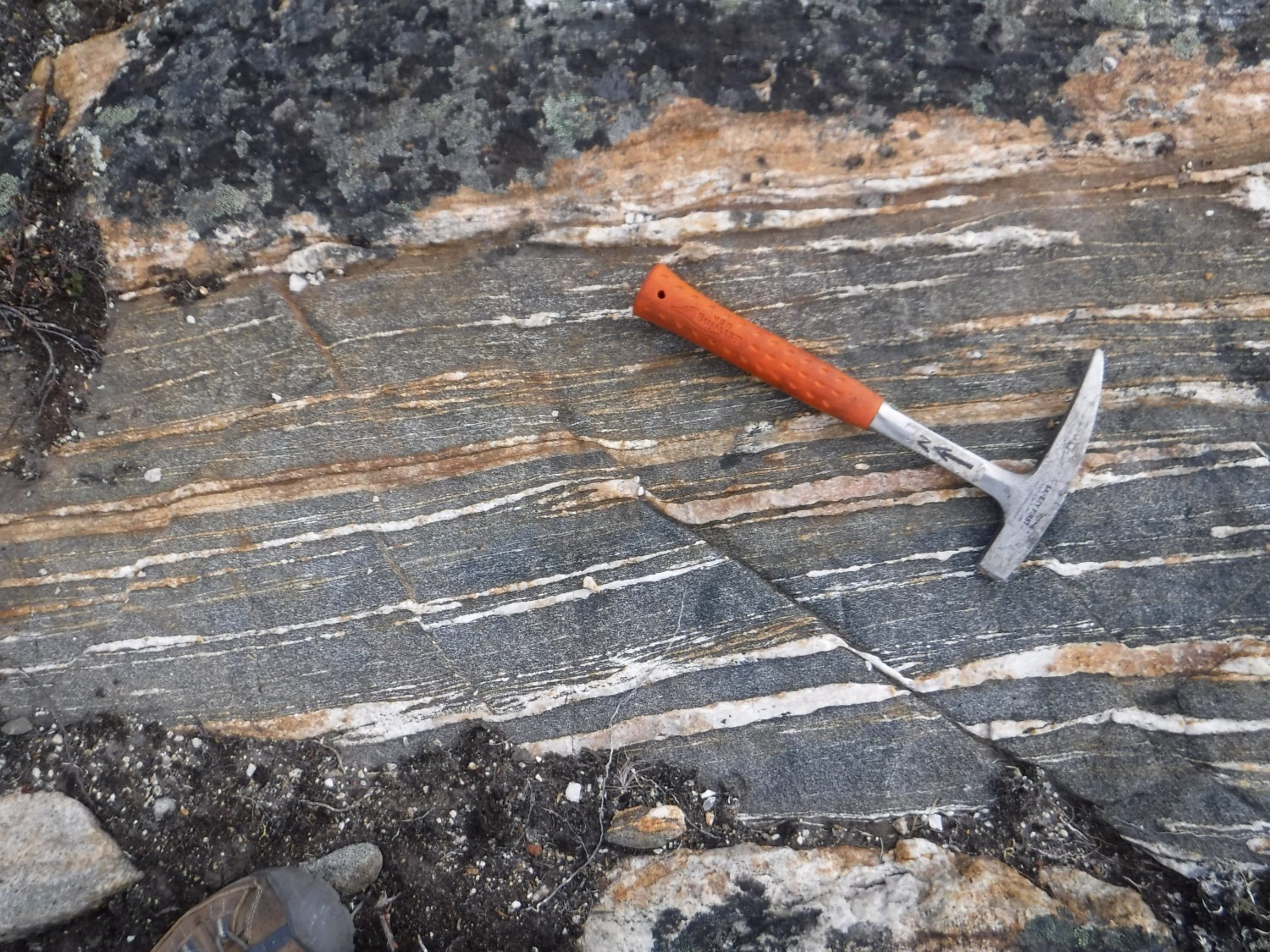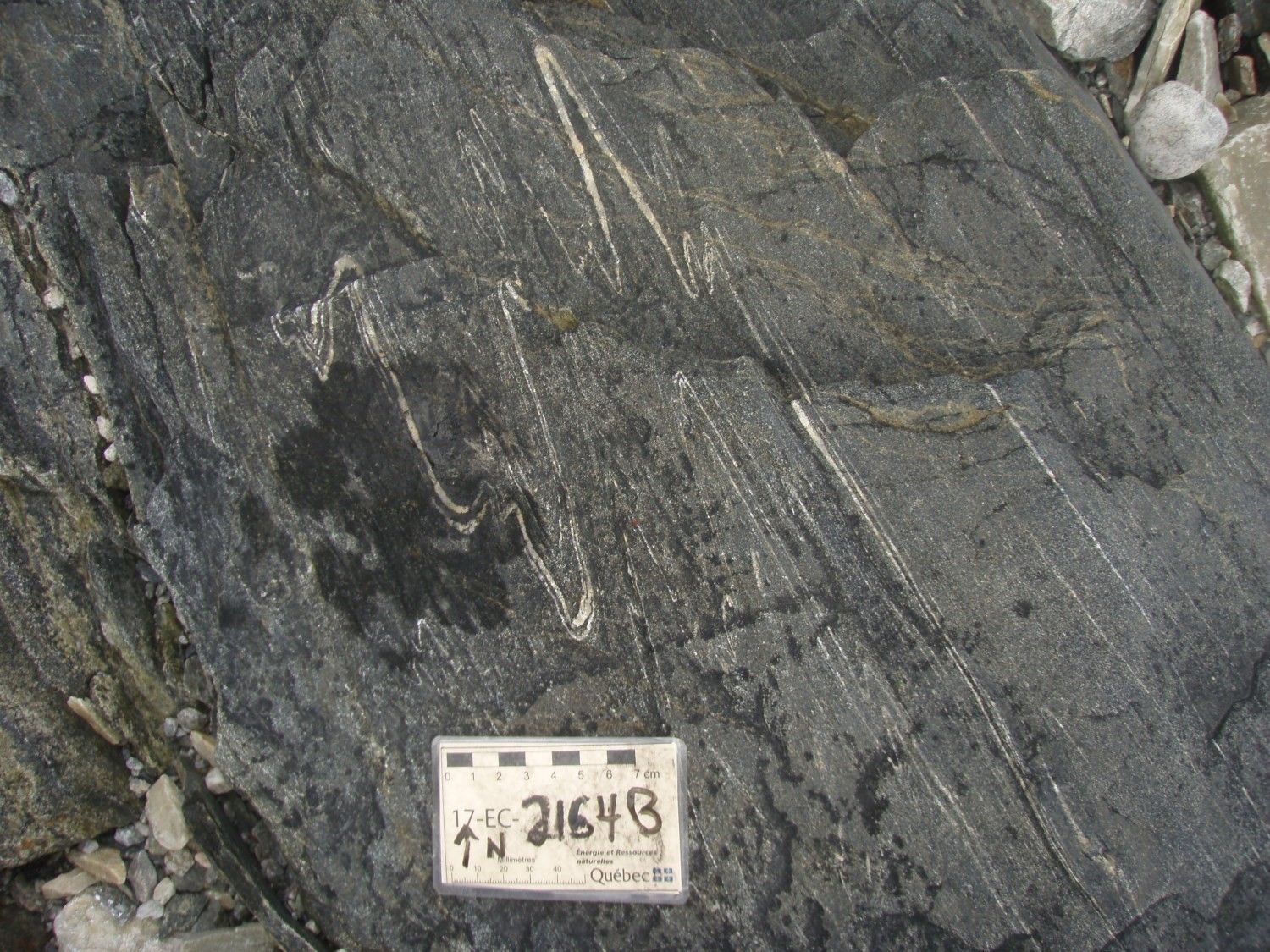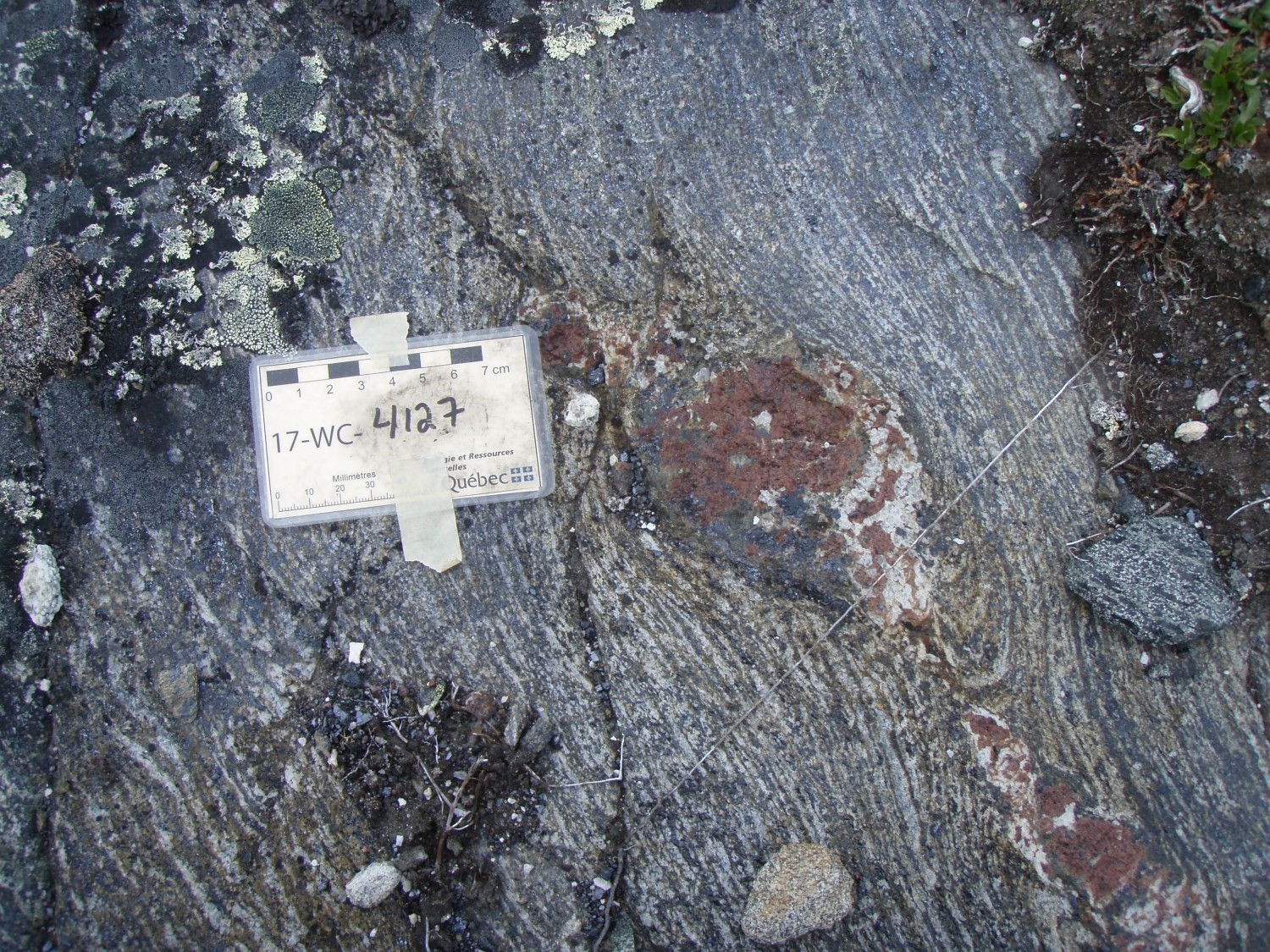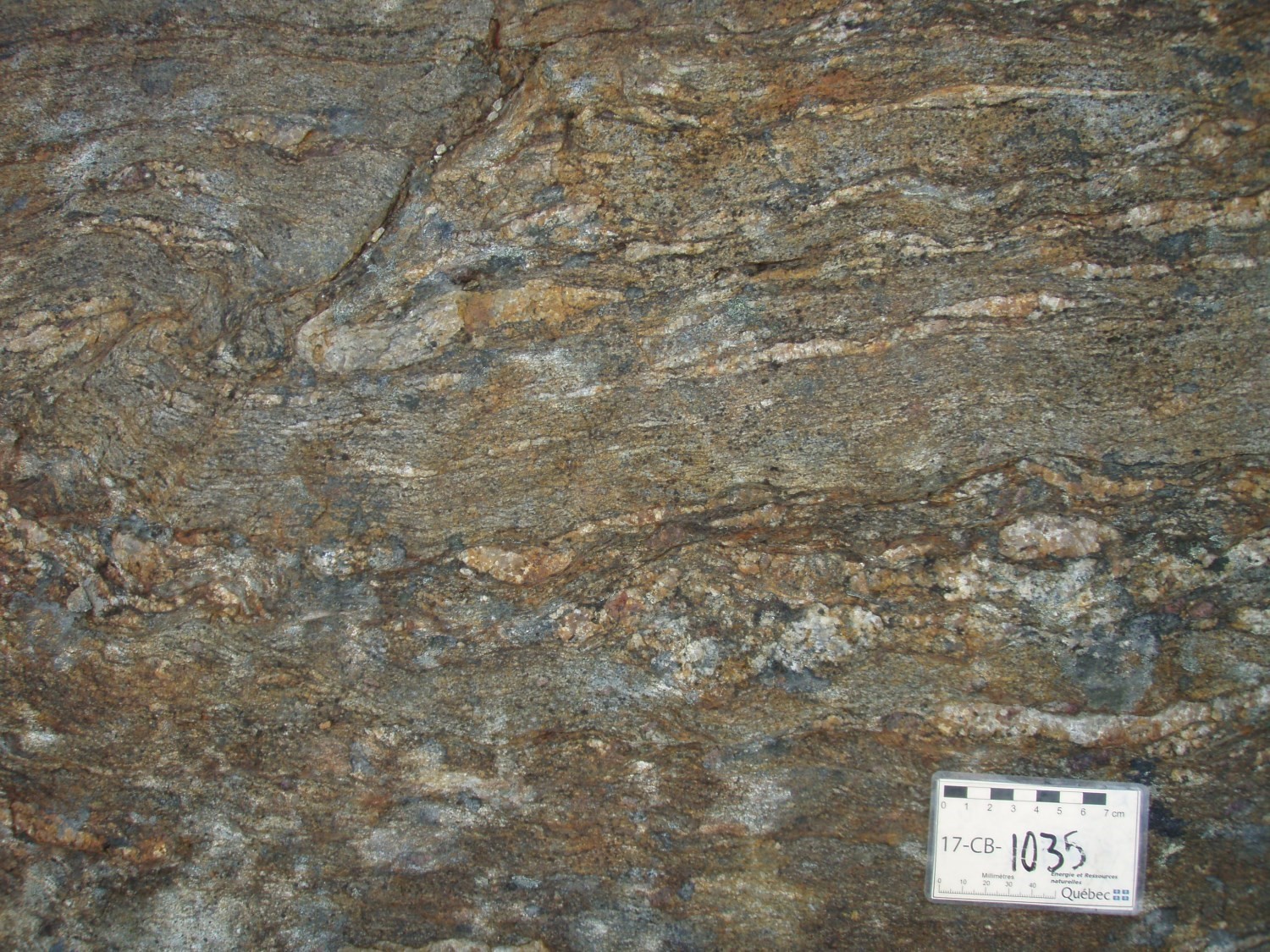
Last modified:
Translation of original French
| Author: | Simard et al., 2008 |
| Age: | Mesoarchean |
| Reference section: | |
| Type area: | Peters Lake area (NTS sheet 24M) |
| Geological province: | Superior Province |
| Geological subdivision: | Minto Subprovince / Rivière Arnaud Terrane / Utsalik Domain / Douglas-Harbour Domain |
| Lithology: | Volcano-sedimentary rocks |
| Type: | Lithodemic |
| Rank: | Complex |
| Status: | Formal |
| Use: | Active |
None
Background
The Douglas-Harbour Domain volcano-sedimentary rocks were recognized by Madore et al. (1999) in the Peters Lake area southwest of Kangirsuk. They were initially included in the Faribault-Thury (renamed Faribault-Thury Suite), Troie and Qimussinguat complexes (Madore and Larbi, 2000; Madore et al., 1999, 2001; Cadieux et al., 2002; Leclair et al., 2000, 2003). All of these volcano-sedimentary rocks were reassigned to the Arnaud Complex, introduced by Simard et al. (2008) to harmonize the stratigraphy of the northeast Minto Subprovince.
Names have been given to the klippes with the largest areas: Curotte, Faribault, Gorribon, Hamelin, Peters-Ouest, River, Tasiaalujjuaq, and Thury belts in the Peters Lake area (NTS sheet 24M; Madore et al., 1999), Buet and Trempe belts in the Arnaud River area (sheet 25D; Madore and Larbi, 2000) and Kimber Belt in the Klotz Lake area (sheet 35A; Madore et al., 2001). The most recent mapping of the Trempe, Thury and Gorribon belts (Bilodeau and Caron-Côté, 2018) has resulted in significant changes to the boundaries of the first two and significant segmentation of the Gorribon Belt.
| Revised and Standardized Units | Previous Units | Reference(s) of Previous Units |
| mAarn1 | Afth3 | Madore et al., 1999, 2001 |
| Afth3a | Madore and Larbi, 2000; Cadieux et al., 2002 | |
| Atie3 | Madore et al., 1999 | |
| Aqim3 | Madore et al., 1999 | |
| Aqim3a | Madore and Larbi, 2000 | |
| mAarn2 | Afth3 | Madore et al., 1999, 2001; Madore and Larbi, 2000; Cadieux et al., 2002 |
| Afth3b | Cadieux et al., 2002 | |
| Atie3 | Madore et al., 1999 | |
| Aqim3 | Madore et al., 1999, 2001 | |
| mAarn3 | Afth3c | Cadieux et al., 2002 |
| mAarn4 | Afth1 | Madore et al., 1999; Cadieux et al., 2002 |
| Atie1 | Madore et al., 1999 | |
| Aqim1 | Madore et al., 1999 | |
| mAarn5 | Afth2 | Madore et al., 1999; Madore and Larbi, 2000; Cadieux et al., 2002 |
| Afth2a | Cadieux et al., 2002 | |
| Atie2 | Madore et al., 1999 | |
| Aqim2 | Madore et al., 1999 |
Description
The Arnaud Complex is made up of supracrustal rocks, dominated by mafic volcanics, and contains a lower proportion of ultramafic intrusions. This complex is subdivided into five (5) informal units: 1) ultramafic rocks (metavolcanics or sills) (mAarn1); 2) amphibolite and mafic gneiss (mAarn2); 3) dacite and rhyodacite (mAarn3); 4) iron formation unit (mAarn4); and 5) paragneiss, diatxite, quartzite, marble and calc-silicate rocks (mAarn5). The Arnaud Complex’s rocks, which are hosted by the Faribault-Thury Suite, are usually metamorphosed to amphibolite facies, while rocks of the Troie and Qimussinguat complexes are metamorphosed to granulite facies.
Arnaud Complex 1 (mAarn1): Ultramafic Rocks (Metavolcanics or Sills)
Ultramafic rocks are observed in isolated outcrops and appear interstratified with other volcano-sedimentary units. These rocks consist mainly of pyroxenite, peridotite and rarely dunite. Some of these ultramafic rocks probably represent komatiitic lava (Madore et al., 1999). Rocks are generally medium to coarse grained, heterogeneous, foliated, weakly to strongly altered and rarely massive and fine grained. They are mainly composed of pseudomorphs of clinopyroxene, orthopyroxene and olivine. Secondary mineral phases are anthophyllite, chlorite, epidote, talc and serpentine (Madore et al., 1999).
Arnaud Complex 2 (mAarn2): Amphibolite and Melanocratic Mafic Gneiss
This unit consists of mafic to locally intermediate amphibolite and mafic gneiss. These rocks are interbedded in several locations with other units of the Arnaud Complex, which are presented in the form of decimetric to decametric paragneiss, marble and iron formation horizons. Rocks are generally fine to medium grained and have a granoblastic texture. Amphibolite has penetrative foliation, a nematoblastic texture, and millimetric banding, while mafic gneiss has centimetric compositional banding. It is locally migmatized, cut by veins, and contains clusters of granitic and tonalitic material (Madore et al., 2001).
Madore et al. (1999) locally observed massive in appearance rocks and primary volcanic structures, such as pillows, as well as crystal, lapilli and block tuffs facies in the belts hosted in the Faribault-Thury Suite. Grain size, heterogeneity, and relationship to host rocks were also used as criteria for distinguishing metavolcanics from metagabbros (Madore et al., 1999, 2001; Madore and Larbi, 2000).
The belts in the Faribault-Thury Suite show paragenesis of the amphibolite metamorphic facies. Mafic rocks are mainly composed of green hornblende and plagioclase. Minor and accessory phases are weakly chloritized biotite, quartz, epidote, sphene, garnet and clinopyroxene relics. Klippes included in the Troie and Qimussinguat complexes contain granulite facies parageneses, the dominant phases of which are plagioclase, orthopyroxene, clinopyroxene and secondary green hornblende. Minor mineral phases are biotite, quartz, magnetite and other less abundant opaque minerals.
Arnaud Complex 3 (mAarn3): Dacite and Rhyodacite
According to Cadieux et al. (2002), “felsic volcanics are leucocratic, white to light grey. These rocks are foliated to mylonitic and generally show good lineation. They are homogeneous, fine grained and contain quartz (rhyodacite) and/or plagioclase (dacite) phenocrystals. Their general composition includes quartz, plagioclase, biotite, muscovite and sericite. They contain rusty zones containing up to 5% disseminated pyrite.”
Arnaud Complex 4 (mAarn4): Iron Formation
Iron formation occurs in the form of metric to decametric horizons and can reach hectometric thickness in some locations. It is usually interstratified with paragneiss, quartzite or metavolcanics. It is observed in contact with orthogneiss and intrusive rocks (Madore et al., 1999). Iron formation is banded, marked by alternating millimetric to centimetric bands of the oxide and silicate facies, and is generally deformed and folded.
Iron formation is metamorphosed to amphibolite facies when hosted in tonalitic gneiss of the Faribault-Thury Suite. The silicate facies consists mainly of quartz, garnet, locally grunerite, and contains smaller amounts of magnetite, hornblende, biotite, calcite and pyrite, as well as traces of apatite and zircon. The oxide facies consists mainly of quartz and magnetite, as well as some minor phases such as grunerite, garnet and apatite.
Klippes included in the Troie and Qimussinguat complexes have a granulite facies paragenesis. The silicate facies consists mainly of quartz and garnet. Orthopyroxene and clinopyroxene are present in places and appear to be the result of grunerite replacement. Pyroxenes are locally replaced by hornblende. Minor phases are dominated by fine-grained magnetite and porphyroblastic biotite. The oxide facies consists mainly of quartz, magnetite and contains, more locally and in smaller proportions, clinopyroxene partially replaced by hornblende, biotite and apatite (Madore et al., 1999).
Arnaud Complex 5 (mAarn5): Paragneiss, Diatexite, Quartzite, Marble and Calc-silicate Rocks
This unit is dominated by paragneiss, which is interbedded with lower proportions of quartzite, diatexite, marble and calc-silicate rock horizons. Klippes hosted in the Faribault-Thury Suite have lateral extensions of a few kilometres, while those within the Qimussinguat and Troie complexes are only observed very locally and have hectometric lateral extensions (Madore et al., 1999).
Paragneiss is essentially hosted by the Faribault-Thury Suite, and is the predominant lithology of this unit. It is slightly migmatitized and shows tectono-metamorphic banding. It is composed mainly of quartz, plagioclase, biotite and garnet. It is usually fine to medium grained, has biotite-marked lepidoblastic foliation and a granoblastic quartzofeldspathic matrix. Accessory minerals are hornblende, sillimanite, graphite, muscovite, rutile and tourmaline. Biotite is locally chloritized and garnet is commonly porphyroblastic and poikilitic, containing inclusions of biotite, sillimanite, quartz, plagioclase or graphite.
Diatexite is uncommon in klippes hosted in the Faribault-Thury Suite. Diatxite comes after paragneiss hosted in the Troie and Qimussinguat complexes, and is indicative of a significant partial melting rate. Sometimes, diatexite is found hosted in the Faribault-Thury Suite. Paragneiss is highly migmatitized and has penetrative tectono-metamorphic banding. The mobilisate is of tonalitic to granitic composition and reaches up to 60% of the rock (Madore et al., 1999; Cadieux et al., 2002). The paleosome has characteristics similar to paragneiss hosted in the Faribault-Thury Suite, namely fine grain size and a granoblastic quartzofeldspathic matrix. Minor and accessory mineral phases are garnet, biotite, cordierite, spinel and sillimanite.
Quartzite consists of fine to medium-grained granoblastic quartz. It has massive to laminated textures and has a saccharoidal appearance. Accessory mineral phases are garnet, biotite, muscovite, magnetite, sillimanite and pyrite.
Marble is in negative relief from adjacent lithologies. In thin section, it shows complete recrystallization. Neoblasts are medium to locally coarse grained. Marble consists mainly of calcite or dolomite, and contains about 15% secondary minerals including diopside, forsterite, sphene and humite group minerals. These minerals are concentrated in millimetric to centimetric bands defining tectono-metamorphic banding (Madore et al., 1999).
Calc-silicate rocks were only observed very locally. They have a granoblastic texture and fine to medium grain size. These rocks have millimetric tectono-metamorphic banding where each band contains varying proportions of diopside, calcite, scapolite, sphene, quartz, plagioclase and hornblende (Madore et al., 1999).
Thickness and Distribution
The Arnaud Complex consists of volcano-sedimentary rock klippes in the Douglas Harbour Domain, the northeastern part of the Minto Subprovince. These klippes are scattered throughout the Faribault-Thury Suite as well as the Troie and Qimusinguat complexes. They are included in an area extending approximately 300 km in a north-south direction and 150 m in an east-west direction, primarily in sheets 24M and 25D and, in a lesser part, in NTS sheets 24L, 34P, 35A, 35H and 25E. The majority of the known klippes are hosted in the Faribault-Thury Suite, between the Troie and Qimussinguat complexes, west of the Troie Complex. They are generally 50 m to 5 km thick and 1 to 20 km long.
Dating
The Arnaud Complex’s volcano-sedimentary rocks have a wide range of emplacement ages, ranging from 2870 to 2718 Ma. Some of these rocks are hosted in ancient tonalitic bedrock klippes (2879 to 2857 Ma; David et al., 2009) within the Faribault-Thury Suite, and may, therefore, have an equivalent age to the Gayot Complex (2880 to 2873 Ma), located in the La Grande Subprovince (Simard et al., 2008). Another Pb/Pb age of 2818 ±5 Ma was obtained from a metavolcanic rock of the Buet Belt (David et al., 2009). A Pb/Pb age of 2782 ±7 Ma was obtained from a quartz-feldspar porphyry (QFP) sill in the Curotte Belt (David et al., 2009). This sill is conformable with volcanic rock stratigraphy and is interpreted as synvolcanic (Madore et al., 1999). The age of 2782 ±7 Ma is interpreted as the period of emplacement (Madore et al., 1999; David et al., 2008). Also, detrital zircon in a quartzite and a marble were found to have maximum sedimentation ages of 2725 ±9 Ma and 2718 ±9 Ma, respectively (David et al., 2009). These sedimentary rocks are found in the Peters-Ouest Belt formerly included in the Troie Complex (Madore et al., 1999).
| Isotopic System | Mineral | Crystallization Age (Ma) | (+) | (-) | Reference(s) |
| Pb/Pb | Zircon | 2818 | 5 | 5 | David et al., 2009 |
| Pb/Pb | Zircon | 2782 | 7 | 7 | David et al., 2009 |
| Pb/Pb | Zircon | 2725 | 9 | 9 | David et al., 2009 |
| Pb/Pb | Zircon | 2718 | 9 | 9 | David et al., 2009 |
Stratigraphic Relationship(s)
The Arnaud Complex is found only in the form of kilometric enclaves or klippes hosted in tonalitic rocks of the Faribault-Thury Suite and in the Troie and Qimussinguat complexes. Finally, it is noted locally that the Klotz and Payne River Paleoproterozoic dykes cut all these Archean rocks, including the Arnaud Complex.
Paleontology
Does not apply.
References
| Author(s) | Title | Year of Publication | Hyperlink (EXAMINE or Other) |
|---|---|---|---|
| BILODEAU, C. – CARON-COTÉ, E. | Géologie de la région de la rivière Arnaud, provinces du Supérieur (Minto) et de Churchill (Fosse du Labrador), secteur de Kangirsuk, Nunavik, Québec, Canada. Ministère de l’Énergie et des Ressources naturelles, Québec. | 2018 | Bulletin géologiQUE |
| CADIEUX, A.-M. – BERCLAZ, A. – LABBÉ, J.-Y. – LACOSTE, P. – DAVID, J. – SHARMA, K.N.M. | Géologie de la région du lac Pélican (SNRC 34P). Ministère des Ressources naturelles, Québec; RG 2002-02, 49 pages. | 2002 | |
| DAVID, J. – MAURICE, C. – SIMARD, M. | Datations isotopiques effectuées dans le nord-est de la Province du Supérieur – Travaux de 1998, 1999 et 2000. Ministère des Ressources naturelles et de la Faune, Québec; DV 2008-05, 92 pages. | 2009 | DV 2008-05 |
| LECLAIR, A.D. – PARENT, M. – DAVID, J. – DION, D.-J. – SHARMA, K.N.M. | Géologie de la région du lac La Potherie (SNRC 34I). Ministère des Ressources naturelles, Québec; RG 2000-12, 46 pages. | 2000 | RG 2000-12 |
| LECLAIR, A. – BERCLAZ, A. – PARENT, M. – CADIEUX, A.-M. – SHARMA, K.N.M. | Géologie 1/250 000, 24L – LAC DUFREBOY. Ministère des Ressources naturelles, Québec; carte SI-24L-C2G-03C. | 2003 | Carte SI-24L-C2G-03C |
| MADORE, L. – BANDYAYERA, D. – BÉDARD, J.H. – BROUILLETTE, P. – SHARMA, K.N.M. – BEAUMIER, M. – DAVID, J. | Géologie de la région du lac Peters (SNRC 24M). Ministère des Ressources naturelles, Québec; RG 99-07, 41 pages. | 1999 | RG 99-07 |
| MADORE, L. – LARBI, Y. – SHARMA, K.N.M. – LABBÉ, J.-Y. – LACOSTE, P. – DAVID, J. – BROUSSEAU, K. – HOCQ, M. | Géologie de la région du lac Klotz (35A) et du Cratère du Nouveau-Québec (1/2 sud de 35H). Ministère des Ressources naturelles, Québec; RG 2001-09, 44 pages. | 2001 | RG 2001-09 |
| MADORE, L. – LARBI, Y. | Géologie de la région de la rivière Arnaud (SNRC 25D) et des régions littorales adjacentes (SNRC 25C, 25E et 25F). Ministère des Ressources naturelles, Québec; RG 2000-05, 37 pages. | 2000 | RG 2000-05 |
| SIMARD, M. | Lexique stratigraphique des unités archéennes du nord-est de la Province du Supérieur. Ministère des Ressources naturelles et de la Faune, Québec; DV 2008-03, 107 pages. | 2008 | DV 2008-03 |
| SIMARD, M. – LABBÉ, J.-Y. – MAURICE, C. – LACOSTE, P. – LECLAIR, A. – BOILY, M. | Synthèse du nord-est de la Province du Supérieur. Ministère des Ressources naturelles et de la Faune, Québec; MM 2008-02, 196 pages. | 2008 | MM 2008-02 |


